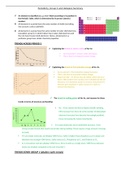Summary
A level Chemistry: Periodicity, Group 2 and Halogens FULL A* SUMMARY NOTES
A-level Chemistry Full A/A* Summary Notes on Periodicity, Group 2 and Halogens. (Alkaline Earth Metals and Group 7). AQA, OCR, WJEC Eduqas, Edexcel, Cambridge, GCSE, IB. Easy to understand. Typed Lecture Notes from a top student. Cheap and affordable.
[Show more]




